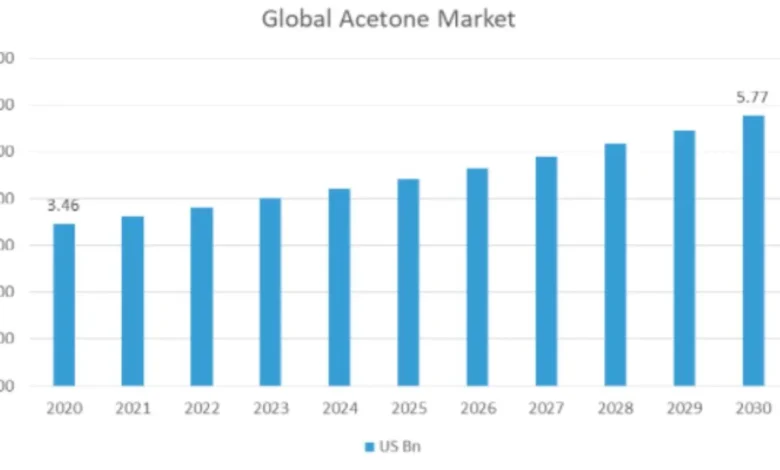5 Factors That Affect Acetone Prices

When the conversation surrounds chemicals, it becomes nearly impossible for one to miss out on acetone, a regular in our quotidian existence. For the unversed, however, acetone is an achromatic, somewhat aromatic, solvent, mainly produced as a byproduct of the cumene-phenol process. Also referred to as a chemical intermediate, it is highly flammable and volatile in nature, yet grades low on the toxicity level. Read on to get a primer on its various uses and how they affect acetone prices in the chemical industry.
A Look at the Various Uses of Acetone
Acetone plays a significant role in countless industrial processes such as:
Production of Chemicals: Acetone is used as a prime solvent to produce chemicals like methyl methacrylate, bisphenol-A, etc. It is also used as a chemical intermediate in the coalescence of varied compounds.
Production of medications: Acetone helps in the production of a number of medicines and vitamins as well. Some of them are Allegra-D 24 Hour, Azulfidine EN-tabs, etc.
Production of Plastics & Resins: Acetone can easily dissolve and blend polymers, including polycarbonate and acrylics, to create plastics of various kinds.
Production of Cosmetics: Since acetone has the potential to entirely dissipate nail paint, it gets used in the production of nail polish removers. Other cosmetics like makeup removers and skin cleansers also warrant its usage.
Production of Adhesives: Capable of thinning thick and coarse solutions, acetone is ideal for use in the formulation of adhesives, glues, and pastes.
Production of Paints & Coatings: Its solvency is also made use of in the manufacturing of paints, as it makes the dissolution of resins and pigments easy, ensuring the paint is thin enough for smooth application.
A Cleaning Agent: Manufacturing units and automobile shops employ it to clean oil and other pollutants from cars and machines. Likewise, laboratories use it to clean glass apparatuses and other equipment due to its dissolving efficacy. It is used as a household cleaner as well.
A Look at the Various Factors That Affect Acetone Prices
Since acetone finds its usage in almost every industry out there, it is contingent on market trends and demand-supply scenarios that affect its overall pricing. Here’s a comprehensive look at a few of them:
Cost of Production: Since acetone is primarily manufactured using the cumene peroxidation process, its overall cost becomes susceptible to any changes in the prices of benzene and propylene, both of which are used as raw materials in the process. Crude oil, the precursor of the aforesaid petrochemicals, further adds on to the variability in acetone prices.
Demand for Acetone: Akin to the prices of any other commodity, prices of acetone lie at the mercy of its supply and demand dynamics. As the demand or preference for acetone surges or declines, acetone prices fluctuate alongside.
The Concerns of Mother Nature: As the world is increasingly becoming aware of the growing environmental concerns, industries everywhere are looking for ways to become sustainable in their ways. As a result of which, we now have several other bio-based and renewable ways to produce acetone. As more and more industries in the sector resort to these green alternatives, production costs and as a result, market prices of acetone are bound to get impacted.
Regional Differences: Every region has its own set of supply-chain dictates and trade dynamics that impact the availability, demand, and prices of the commodities traded therein. Similar is the case with acetone, that is to say that the rate at which it is available in one market does not necessarily have to be what it is in any other market. A slew of factors are at play here and the stakeholders need to take stock of each and every one of them before indulging in trade.
Technological Advancements: Just like any other sector, advancements in technology have led to significant changes in the acetone market as well. Acetone-based products, for instance, are now being remodelled to meet the ever-increasing demand for lightweight materials in automotive applications, vapour smoothing in 3D printing and so on and so forth. These innovations influence the pricing of acetone to a great extent.
A Look at Acetone Market’s Prospects for the Future
The global acetone market size was reported to have a value of approximately 6.5 Billion USD in 2024 and is forecasted to reach 12.4 Billion USD by 2033, recording a CAGR of 5.6%. These figures denote that the market is set to rise in the coming future and beyond, and so, the market players should make themselves cognizant of its intricacies, the sooner, the better.
If you are wondering about the right platform to check acetone and butyl acetate prices, OfBusiness is the answer for you. The B2B platform provides the latest prices of chemicals along with industry updates.
Read More: 9 Helpful Tips for Train Travel in India




